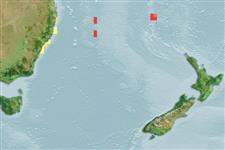Classification / Names
Noms communs | Synonymes | Catalog of Fishes(Genre, Espèce) | ITIS | CoL | WoRMS | Cloffa
>
Gobiiformes (Gobies) >
Gobiidae (Gobies) > Gobiinae
Etymology: Hetereleotris: Greek, heteros = other + The name of a Nile fish, eleotris (Ref. 45335); readerae: Named for Sally Reader, who helped collect the type series.
Eponymy: Sally E Reader is an ichthyologist at the Australian Museum Research Institute. [...] (Ref. 128868), visit book page.
More on authors: Hoese & Larson.
Environment: milieu / climate zone / depth range / distribution range
Écologie
marin démersal; profondeur 6 - 11 m (Ref. 57078). Tropical
Southwest Pacific: eastern Australia.
Taille / Poids / Âge
Maturity: Lm ? range ? - ? cm
Max length : 2.4 cm SL mâle / non sexé; (Ref. 57078); 2.1 cm SL (female)
Description synthétique
Clés d'identification | Morphologie | Morphométrie
Épines dorsales (Total) : 7; Rayons mous dorsaux (Total) : 8; Épines anales: 1; Rayons mous anaux: 8. Diagnosis: Pelvic fins widely separated at base, rays I,5, fifth ray unbranched, distance between bases of inner rays of two fins about equal to base of either fin. Head pore 1 by each posterior nostril, a single anterior interorbital pore, a single posterior interorbital pore, a supraorbital pore behind eye, an infraorbital pore below supraorbital pore behind eye, a lateral canal pore behind infraorbital pore, a terminal lateral-canal pore over preopercular margin, and two preopercular pores. The first gill-arch is connected by membrane to inside of gill cover. The gill opening restricted to depth of pectoral base. Anterior nostril tubular; posterior nostril a simple pore or with slightly elevated anterior rim. In males, the first two dorsal spines prolonged or not. First dorsal fin without prominent black spots or dark lines, often with small brown irregular marks near the base of the fin. A black spot subequal to pupil diameter is found behind the eye. Second dorsal-fin rays I,8 (Ref. 57078).
Collected in rocky areas with some coral (Ref. 57078).
Life cycle and mating behavior
Maturité | Reproduction | Frai | Œufs | Fécondité | Larves
Hoese, D.F. and H.K. Larson, 2005. Description of two new species of Hetereleotris (Gobiidae) from the south Pacific, with a revised key to species and synonymization of the genus Pascua with Hetereleotris. Zootaxa 1096:1-16. (Ref. 57078)
Statut dans la liste rouge de l'IUCN (Ref. 130435: Version 2024-2)
Menace pour l'homme
Harmless
Utilisations par l'homme
Outils
Articles particuliers
Télécharger en XML
Sources Internet
Estimates based on models
Preferred temperature (Ref.
123201): 20.9 - 22.3, mean 21.6 °C (based on 22 cells).
Phylogenetic diversity index (Ref.
82804): PD
50 = 0.5000 [Uniqueness, from 0.5 = low to 2.0 = high].
Bayesian length-weight: a=0.01023 (0.00477 - 0.02194), b=3.01 (2.83 - 3.19), in cm total length, based on LWR estimates for this (Sub)family-body shape (Ref.
93245).
Niveau trophique (Ref.
69278): 3.1 ±0.3 se; based on size and trophs of closest relatives
Résilience (Ref.
120179): Haut, temps minimum de doublement de population inférieur à 15 mois (Preliminary K or Fecundity.).
Fishing Vulnerability (Ref.
59153): Low vulnerability (10 of 100).
